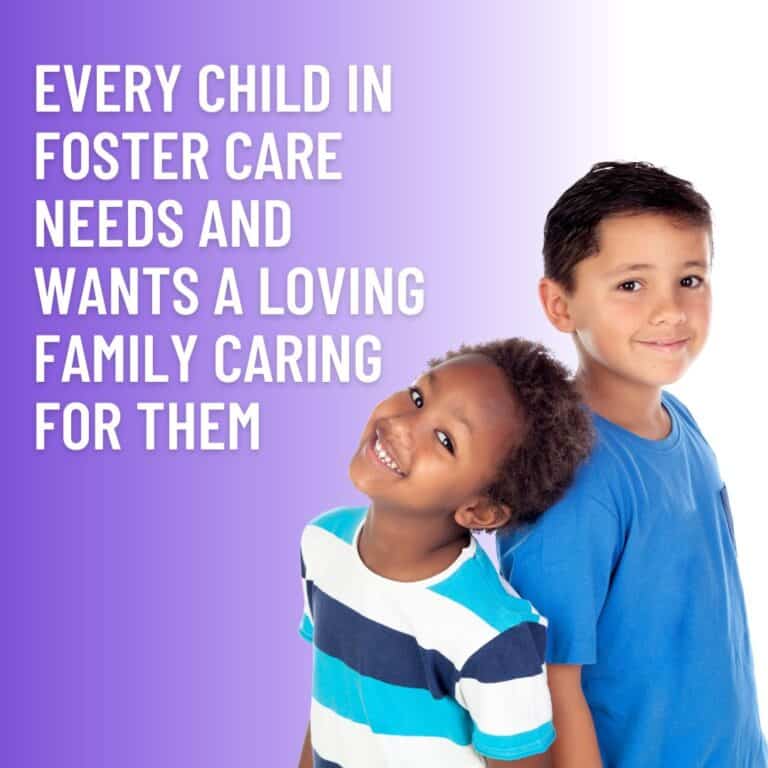Whether you live in a large city or in a rural community, your home could be the safe place a child in foster care needs for a few days, several months, or a season so they can heal. These lonely children need your family. To be that loving caregiver, you need to learn how to become a foster parent.
Across the nation children of all ages enter the foster care system due to abuse and/or neglect or abandonment. These safety issues put children in harms way
Requirements to Become a Foster Parent
Individuals must be at least 21 years of age.
You must be able to care for your family financially without the child’s stipend.
It is vital to be flexible, patient, and understanding.
Having a sense of humor can help you make it through difficulties and challenges.
If you have lived in a different state in the last two years, you may need to pass additional clearances.
Your physician is a good judge of whether you have any medical conditions that might impact your ability to care for a child. Everyone in the home must pass a physical examination and be current with vaccinations.
A caseworker will meet with the family 2 -3 times in their home and interview the husband and wife separately and then together. Children in the home will participate in an age-appropriate interview. If other adults live in the home, the family assessment will also include them. Discussions will include but not be limited to: Understanding the family’s motivation to become foster parents, if foster is a good fit for your family, the potential impact of fostering on your children, and personal references.
The caseworker will assess your home for fire and safety hazards, as well as, space to ensure your home has space to accommodate additional children being housed in your home. Children of the same sex may share a bedroom. However, each child must have their own bed and adequate space for their things.
These trainings may last 10 to 12 weeks. The training prepares you to know about the agency’s policies and requirements. It also includes training on how to work with biological family members, helping children adjust to changes, parenting dynamics, and demonstrate the ability to work as a member of the team. (The length of classes may vary by state.)
The family must have proof that all pets are current with their vaccinations.
Safety is critical. These classes help you prepare in case of an emergency. you hope you never need to use these skills but if you need them, you will be glad you have them.
Valid identification, such as a current driver’s license or state identification card is required.
The Child Welfare Information Gateway – State Resources is a great place to find contact information for your state. Look for the Foster Care & Adoption Directory.

Levels of Family Foster Care
There are several levels of family foster care. Homes approved for higher levels of care are provided with additional training, support, and services to ensure that the needs of the children are appropriately addressed. All foster care families are encouraged to access respite care.
Provides care for a child or young person in need of basic care, nurturing, and supervision.
Serves children and youth with greater needs of care, nurturing, and supervision.
Designed to serve children and youth with emotional or behavioral needs that need a higher level of supervision and support.
Serves children and youth with medical needs that require specialized training and skills.
Mark 9:37 ESV says, “Whoever receives one such child in my name receives me, and whoever receives me, receives not me but Him who sent me.”
Who are the Children in Foster Care?
Children enter foster care because they are at risk of being victims or have experienced abuse or neglect. There are less than 400,000 children in some level of foster care. Approximately 51% are male and 49% are female. The average length of time in care is 22 months. They represent all ages between 0 – 18 and various race and ethnicities.
Your Home – The Hospitality Station
1 Peter 4:9 ESV says, “Show hospitality to one another without grumbling.”
Hospitality is the friendly and generous reception and entertainment of guests, visitors, or strangers. It is is the practice of welcoming, sheltering, and feeding – with no thought of personal gain – those who come to your door. Hospitality is sharing what we have and who we are with whomever God sends.
Foster families embrace several levels of hospitality:
- Preparing a home that invites the child/ren in.
- Having food and beverages that are nutritional but also meet the child’s needs. Having meals that embrace the child’s culture and ethnicity. Allowing the child, when appropriate, to assist in menu choices, shopping, food preparation and setting the table.
- Providing transportation to parenting visits, school, medical appointments, and other events.
- Embracing the child’s spiritual, educational, emotional, and social needs.
Matthew 24:45-46 ESV says, “Who then is the faithful and wise servant, whom his master has set over his household, to give them their food at the proper time? Blessed is that servant who his master will find so doing when he comes.”
The Need for More Foster Parents
Every state needs more foster parents. There is a shortage of foster parents in every state for sibling groups and teens. When sibling groups enter foster care caseworkers look for foster parents that can take all the kids. However, what often happens is the younger siblings are placed together while the older siblings are placed in a different home. That is, if one is available. When foster homes are not available to take preteens and teens, they are sometimes placed in Group Homes. (A group home is a private residence licensed for children, teenage boys, and girls, who cannot live with their families due to abuse or neglect.) This is a higher level of care than perhaps the teen needs.
“I didn’t want to, but I had to. I decided I had to let my little sister go. She needed a family more than I did. So, I let go. I figured I could take it… Being with a bunch of kids. She needed a mom and a dad. I wanted one. But she needed one, so I let her go. I tried my best to take care of her. My caseworker told me she would keep looking for a home so we could be together. That never happened."
- Arthur, 14 year old boy living in a group home separated from his 3-year-old sister. Tweet

Overcoming the Fear of Becoming a Foster Parent
God tells us in 2 Timothy 1:7 KJV, “For God hath not given us the spirit of fear; but of power, and of love, and of a sound mind.” As Christians we stand on the foundation of God’s word. He reminds us that fear does not come from Him. So, we must be determined to not let fear stand in the way of doing what God has asked us to do. Care for the children. James 1:27 – “Religion that God our Father accepts as pure and faultless is this; to look after orphans and widows in their distress and to keep oneself from being polluted by the world.
I will be the first to tell someone that not everyone is called to foster a child. However, everyone can do something to ‘look after orphans.’
Facts to Consider
Here are some facts for you to consider as you move forward in answering God’s call to serve vulnerable children and teens in your community.
The state or local child welfare agency has legal and physical custody of child removed when they are removed from their birth family.
States require that families desiring to serve as a foster family select a public or private licensed child placement agency.
Some states have contracts with faith based foster care child placement agencies. They recruit, train, and prepare families to serve children and teens in the state’s custody.
Yes, families are required to attend initial training to be approved to foster. Once approved to foster you will annually attend training. Training is a vital part of the process of getting your family ready to care for a child involved with the foster care system. There are policies and procedures that you need to know about so that your family is better equipped to care for the children you will care for in your home.
State child welfare has identified several safety features as criteria for approving a home to care for a child. A fingerprint check is one way to verify if a person has a history of harming another person.
Safety is the number one area of focus for state government. Their goal is to do their best to ensure that when a home is approved to care for a child that they have done their reasonable service to prevent a child from being placed in an unsafe environment.
The family assessment is an integral part of learning about your family, how you parent, how you share your life with others, discovering your motivation to care for a child, any limitations you might have, the number of bedrooms in your home.
Yes, children of the same biological sex may share a bedroom, but each child must have their own bed.
Every state requires prospective foster families to complete the application process. Foster parents have 24 hour care and supervision of the children in their home. Keeping an accurate record of all prescribed and over the counter medication a child is on and when it is dispensed helps the agency stay informed about the child’s care. Journaling about the child’s behaviors, needs or any concerns you have helps you remember to share that information with the licensing worker assigned to your home so if the child needs additional supports, you can show the pattern of behavior and advocate for meeting the child’s needs.
Most states require that the child’s caseworker visit with the child at least one time a month. The visit should be in the home where the child resides. This visit allows the caseworker to see the child where they study, play, and interact with the family. It also provides an opportunity for the child to have a private conversation with their worker.
Visitation is another word for parenting time. Remember foster care is meant to be temporary. As a foster parent you play an important role of supporting the child to keep a healthy attachment with their parents. Parenting time also helps the caseworker be informed about how the parent and child are interacting and their capacity to keep the child safe during supervised and unsupervised visits.
Almost every state is required to have school aged children enrolled and attend public school. To help with educational stability they try to ensure that the student remain in the school they attended prior to entering foster care. Many states allow children to attend faith-based schools if they are fully credentialed by the state’s Department of Education.
Is Physical/Corporal Discipline Allowed?
Almost every state prohibits the use of corporal discipline of children in state custody. The state recognizes that every child needs to be disciplined. However there are several things families need to remember.
- Children in foster care have been abused. The use of physical discipline may be seen as additional abuse.
- Parents have many tools in their toolbox to address behavior issues. The state’s foster parent training courses are designed to equip families with additional resources to address a child’s behavior.
- Many children in foster care that have missed out on parenting, structure, coaching and guidance. Parenting a child and helping them to trust and realign their thinking will have long-lasting effect.

Kids in Foster Care Need Your Love and Prayers
1 Corinthians 13:4-5 says, “Love is patient, love is kind. It does not envy, it does not boast, it is not proud. It does not dishonor others, it is not self-seeking, it is not easily angered, it keeps no record of wrongs.”
Every child in foster care needs and wants a loving family caring for them while their birth family gets the help that they need. Each child needs the love that you have shared with so many others. Every child wants a foster family that will recognize that their birth family has made mistakes. Because of the love of Jesus, you also recognize that they need respect and a chance to turn their lives around. They need help and you and your family could, if you choose, be a part of that help. When God invites us in to serve hurting children and their families, He knows that we are sinners saved by grace and that He has not kept a list of our wrong doings.
1 John 5:2 says, “By this we know that we love the children of God, when we love God and observe His commandments.”
5 Ways to Show Love to Kids in Foster Care
Many children in foster care have missed out knowing the love of a Heavenly Father. They crave His love. As a lover of God, as someone who seeks to observe His commandments, there are many ways you can show love to a hurting child whether you are called to be a foster parent or not.
1. Be a prayer warrior. Intercede in prayer for the children in your community that are victims of abuse and neglect.
2. Ask God. Does He want to use your family to become a foster parent. If He says yes, do not delay, sign up to attend a foster parent orientation to learn more about the process in your state.
3. Train to serve as a volunteer Court Appointed Special Advocate (CASA Volunteer). Be the eyes and ears of the court by spending time with a child/youth in foster care and share reports about their well-being with the court.
4. Become a respite care provider to support the foster parents in your community. Respite care providers must attend foster parent training and follow the process outlined by the state. Once approved they can provide overnight, weekend and temporary care for children to give the foster parents a time away for refreshment and renewal.
5. Consider providing help. This might look like providing weekly meals, helping with laundry, or helping with homework.
“Beloved, let us love one another, for love is from god; and everyone who loves is born of God and knows God.” – 1 John 4:7
As a lover of God, He is waiting for you to have compassion on His children. He made you in His image, Imago Deo. Ask, “What does God want you to do?”




















